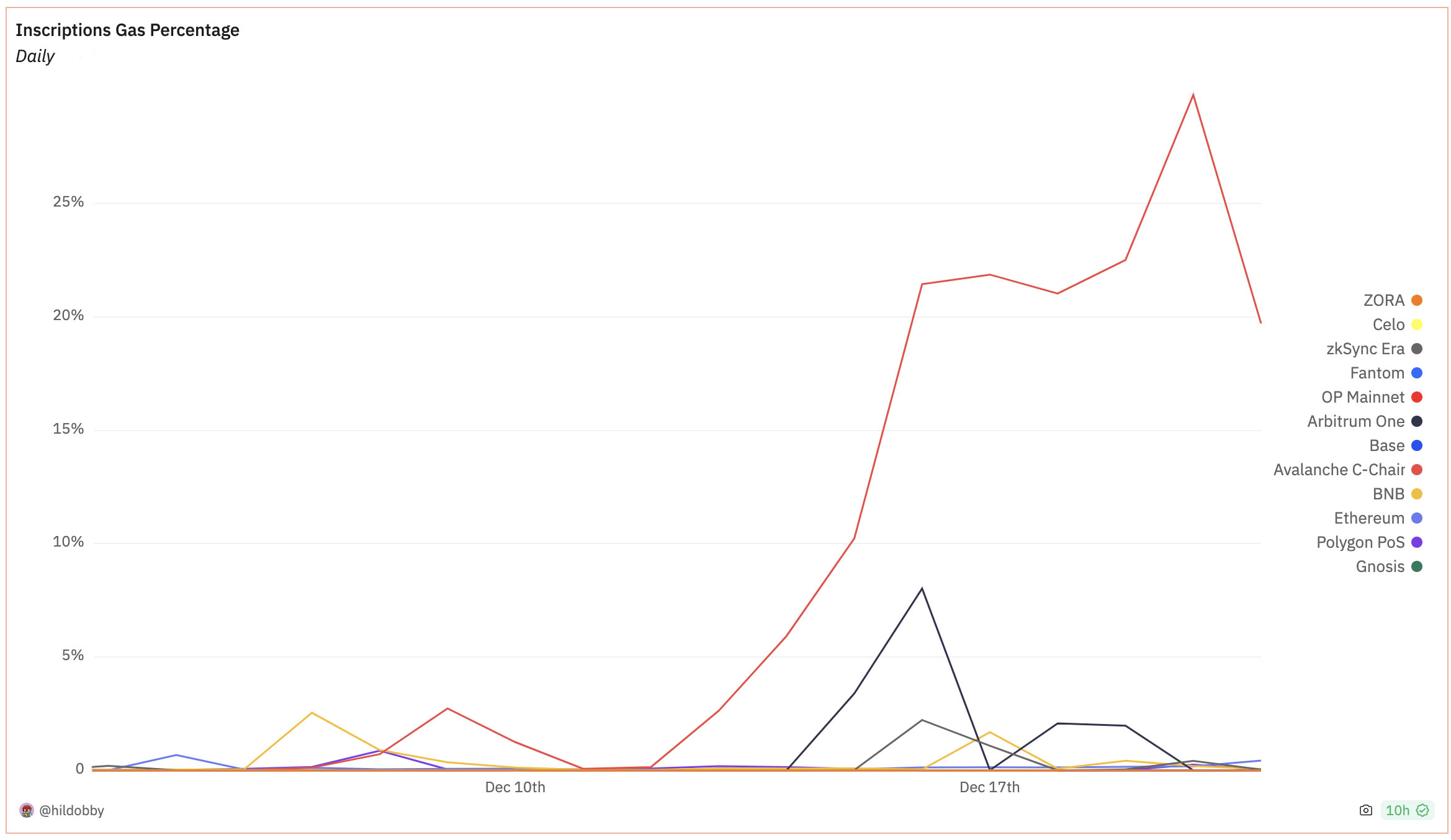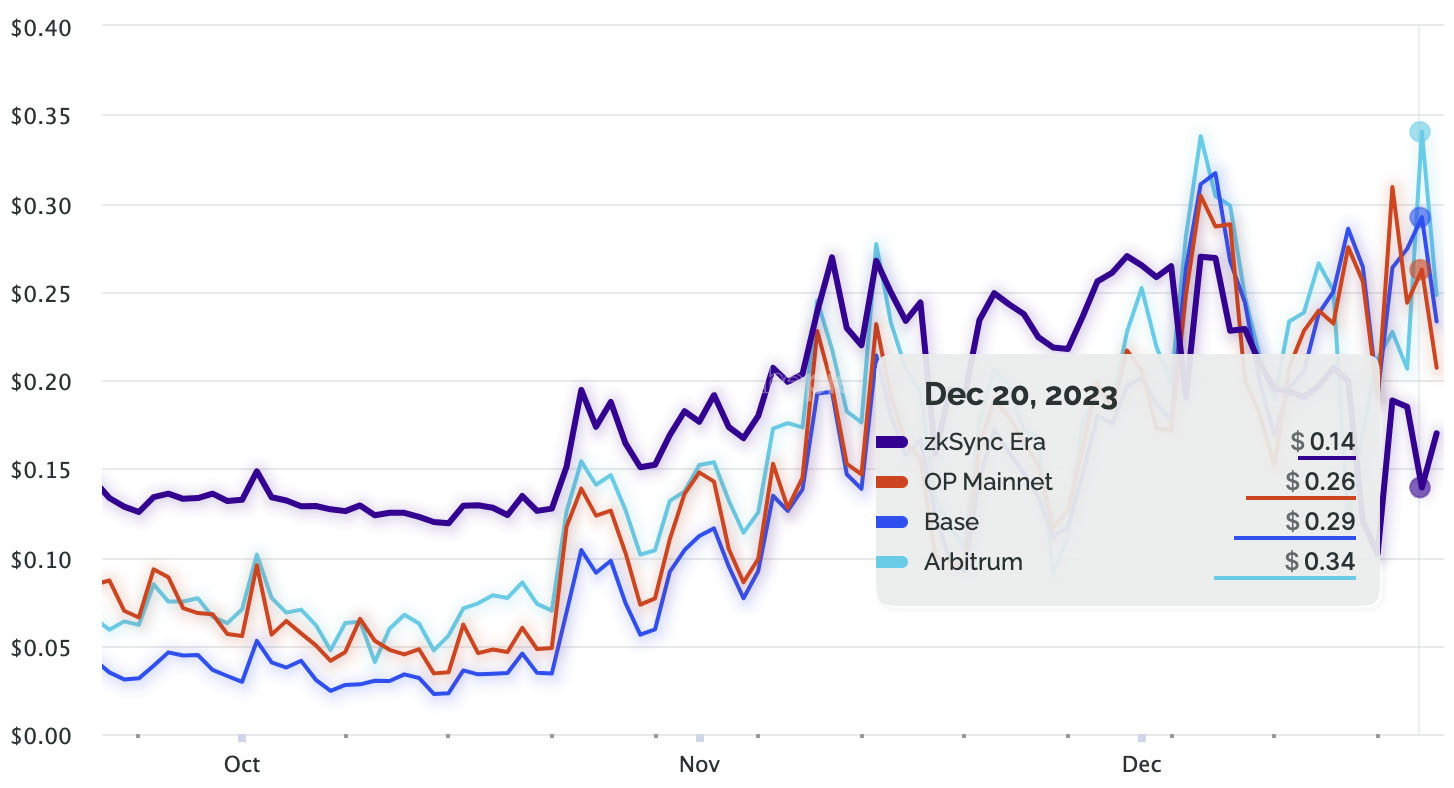The appearance of zero-knowledge proof-based Ethereum rollups represents a major advance in blockchain scalability and effectivity.
Over the previous week, their potential to deal with a spike in transaction volumes was put to the check with the fad-like phenomenon of inscriptions hitting numerous EVM-based networks in sequence.
One facet distinctive to zk-rollups, similar to zkSync, StarkNet and Polygon’s zkEVM, is their potential to amortize the price of producing validity proofs throughout many transactions. Subsequently, not like many blockchains, they really get cheaper to make use of as they scale.
Learn extra: Zero-knowledge rollups get cheaper with scale
Inscriptions refer to varied types of information, sometimes metadata of tokens or NFTs, written to blockchains in a approach which might be less expensive than sensible contracts, as they require much less fuel.
Just lately, there’s been a surge in using inscriptions on quite a lot of networks — not simply Ethereum layer-2s but in addition Avalanche and Solana — primarily for speculative buying and selling of low-value property. This development has led to community congestion and operational disruptions which have saved protocol builders busy discovering methods to mitigate their influence.
In some instances, these disruptions have been extreme — Avalanche’s EVM-compatible C-chain, as an example, noticed the price of transactions spike tenfold, as inscriptions have been briefly answerable for over 30% of all fuel consumed.

Share of fuel attributable to inscriptions, Avalanche in pink. Supply: Hildobby | Dune analytics
ZK magic
To know why proving prices on zk-rollups lower with rising transaction volumes, it’s essential to delve into the mechanics of zero-knowledge proofs and the structure of those rollups.
Zk-rollups make the most of cryptographic strategies, such ZK-STARKs (Zero-Information Scalable Clear Argument of Information), to validate transactions off-chain earlier than submitting them in batches to the Ethereum mainnet.
This batching reduces the variety of transactions that should be processed on-chain, considerably decreasing fuel charges. Because the variety of transactions in a batch will increase, the price per transaction decreases, showcasing economies of scale.
ZkSync Period, at the moment the biggest rollup by total-value locked (TVL), upgraded its authentic SNARK-based prover to 1 based mostly on STARK proofs, known as Boojum, on Dec. 4. It may theoretically deal with 2,000 transactions per second (TPS) — although in follow has but to see a tenth of that. For reference, Ethereum mainnet averages round 15 TPS.
Optimistic rollup Arbitrum, whose 2021 mainnet launch gave it a first-mover benefit, has by far probably the most TVL at $2.4 billion.
Each networks have been impacted by booming inscriptions exercise inside a pair days of one another — which accounted for about 60% of all transactions over the previous week on the pair.
The phenomenon supplied a real-world experiment in Ethereum rollup scaling.
So what occurred?
Each suffered downtime, however transaction charges on Arbitrum spiked, whereas zkSync’s went down.

Transaction price comparability between zkSync and optimistic rollups. Supply: growthepie.xyz
The price of utilizing zkSync has been in a transparent downtrend for the reason that Boojum improve was accomplished earlier this month. The community at the moment has the bottom transactions prices amongst all layer-2s, aggressive with the charges customers pay on optimistic rollups.
However the response to a surge in demand underscores the efficacy of zero-knowledge rollups in upscaling Ethereum’s throughput.
By compressing information and processing transactions in batches, many extra transactions can slot in a single proof to be verified on the Ethereum mainnet.
4/ The minimal bytes per tx we noticed was ~10 bytes throughout the inscription craze. @zksync was packing 5000-7000 transactions right into a single L1 tx.
Have a look at the question – something above 5000 transactions in a L1 tx is seeing INSANELY amortized bytes per tx. pic.twitter.com/pa0FcnlDpv
— taetaehoho (@0xtaetaehoho) December 19, 2023
A researcher at enterprise agency 1kx, often called 0xtaetaehoho, famous on X that the community posted 5,566 proofs on Dec. 17, greater than double the entire pre-Boojum, and did so at a decrease value to the community.
Classes discovered
The visitors did trigger issues for zkSync’s RPC providers and block explorer, nevertheless, prompting Matter Labs to put up an in depth thread of classes discovered.
“This weekend served as an necessary stress-test and an enormous milestone on the way in which of bringing Ethereum to the following billion folks,” the builders stated.
“For practically 14 hours straight, the community dealt with ~150 TPS — peaking at 187 TPS — with a mean [transaction] value of ~$0.12.”
Different Ethereum scaling options, similar to Polygon’s POS chain, additionally dealt with the additional visitors nicely, even with a lot greater volumes.
In line with Polygon founder Sandeep Nailwal, the community notched 18 million transactions per day, whereas fuel charges maxed out on the MATIC equal of $0.10, which he known as “the results of months of effort on EVM parallelisation (BlockSTM) and a number of different hardforks which resulted in diminished reorgs and higher efficiency.”
Polygon’s zkEVM has but to see a major surge in inscriptions-related visitors, however technical lead Jordi Baylina advised Blockworks the discount in proving prices seen in latest months means it’s “not the limiting issue for transactions.”
“For those who examine the [proof] value with information availability value, for instance, and even the cumulative price for the inclusion of the transaction, it’s a lot, a lot decrease,” he stated.
Matter Labs’ head of enterprise growth, Marco Cora, sees a way forward for “a bit of little bit of chaos and disintegration, numerous experimentation, however one wherein one of the best technical options will emerge.
“All people is doing incredible work — all our ‘opponents,’ they’re really tremendous commendable,” Cora advised Blockworks. “Finally we are going to all determine what’s one of the best, and we are going to all converge there.”
One factor that Cora says isn’t unsure is that zero-knowledge tech is the longer term.
“Just about everyone appears to have agreed…Optimism has stated it very explicitly, and Arbitrum I believe has stated it implicitly now that they’re it,” he stated.







